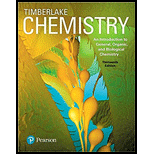
Concept explainers
There are five naturally occurring isotopes of zinc:
Want to see the full answer?
Check out a sample textbook solution
Chapter 4 Solutions
MasteringChemistry with Pearson eText -- ValuePack Access Card -- for Chemistry: An Introduction to General, Organic, and Biological Chemistry
- Xenon An isotope of xenon has an atomic number of 54 and contains 77 neutrons. What is the xenon isotope’s mass number?arrow_forwardA single molecule has a mass of 7.31 1023 g. Provide an example of a real molecule that can have this mass. Assume the elements that make up the molecule are made of light isotopes where the number of protons equals the number of neutrons in the nucleus of each element.arrow_forwardAn element has the following natural abundances and isotopic masses: 90.92% abundance with 19.99 amu, 0.26% abundance with 20.99 amu, and 8.82% abundance with 21.99 amu. Calculate the average atomic mass of this element.arrow_forward
- The natural abundances and isotopic masses of the element neon (Ne) are Calculate the atomic mass of naturally occurring neon.arrow_forwardDefine the term atomic weight. Why might the values of atomic weights on a planet elsewhere in the universe be different from those on earth?arrow_forwardNeon is an inert gas with three stable isotopes. It is used in gas lasers and in advertising signs. Its isotopes and their abundances are: Ne-20 19.9924 amu 90.51% Ne-21 20.9938 amu 0.27% Ne-22 21.9914 amu 9.22% What is the average atomic mass of neon?arrow_forward
- A single molecule has a mass of 7.31 1023 g. Provide an example of a real molecule that can have this mass. Assume the elements that make up the molecule are made of light isotopes where the number of protons equals the number of neutrons in the nucleus of each element.arrow_forwardWhile traveling to a distant universe, you discover the hypothetical element X. You obtain a representative sample of the element and discover that it is made up of two isotopes, X-23 and X-25. To help your science team calculate the atomic weight of the substance, you send the following drawing of your sample with your report. In the report, you also inform the science team that the brown atoms are X-23, which have an isotopic mass of 23.02 amu, and the green atoms are X-25, which have an isotopic mass of 25.147 amu. What is the atomic weight of element X?arrow_forwardA hypothetical element X is found to have an atomic weight of 37.45 amu. Element X has only two isotopes, X-37 and X-38. The X-37 isotope has a fractional abundance of 0.7721 and an isotopic mass of 37.24. What is the isotopic mass of the other isotope?arrow_forward
 Principles of Modern ChemistryChemistryISBN:9781305079113Author:David W. Oxtoby, H. Pat Gillis, Laurie J. ButlerPublisher:Cengage Learning
Principles of Modern ChemistryChemistryISBN:9781305079113Author:David W. Oxtoby, H. Pat Gillis, Laurie J. ButlerPublisher:Cengage Learning Chemistry: Principles and PracticeChemistryISBN:9780534420123Author:Daniel L. Reger, Scott R. Goode, David W. Ball, Edward MercerPublisher:Cengage LearningChemistry: Matter and ChangeChemistryISBN:9780078746376Author:Dinah Zike, Laurel Dingrando, Nicholas Hainen, Cheryl WistromPublisher:Glencoe/McGraw-Hill School Pub Co
Chemistry: Principles and PracticeChemistryISBN:9780534420123Author:Daniel L. Reger, Scott R. Goode, David W. Ball, Edward MercerPublisher:Cengage LearningChemistry: Matter and ChangeChemistryISBN:9780078746376Author:Dinah Zike, Laurel Dingrando, Nicholas Hainen, Cheryl WistromPublisher:Glencoe/McGraw-Hill School Pub Co Introductory Chemistry: A FoundationChemistryISBN:9781337399425Author:Steven S. Zumdahl, Donald J. DeCostePublisher:Cengage Learning
Introductory Chemistry: A FoundationChemistryISBN:9781337399425Author:Steven S. Zumdahl, Donald J. DeCostePublisher:Cengage Learning Chemistry: Principles and ReactionsChemistryISBN:9781305079373Author:William L. Masterton, Cecile N. HurleyPublisher:Cengage Learning
Chemistry: Principles and ReactionsChemistryISBN:9781305079373Author:William L. Masterton, Cecile N. HurleyPublisher:Cengage Learning Chemistry by OpenStax (2015-05-04)ChemistryISBN:9781938168390Author:Klaus Theopold, Richard H Langley, Paul Flowers, William R. Robinson, Mark BlaserPublisher:OpenStax
Chemistry by OpenStax (2015-05-04)ChemistryISBN:9781938168390Author:Klaus Theopold, Richard H Langley, Paul Flowers, William R. Robinson, Mark BlaserPublisher:OpenStax





